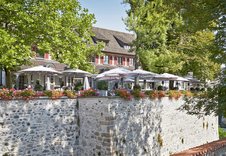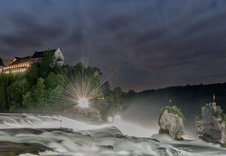For more than 1,100 years, Schloss Laufen at the Rhine Falls has witnessed many societal and political upheavals.It has not been unusual for the castle itself – due to its privileged location – to be at the centre of disputes. Visit the historical building and experience history.





While the City of Schaffhausen has its eye on this strategic place, Hans Wilhelm von Fulach sells the castle and barony to the City of Zurich in 1544. The welcome expansion of territory in the north with the castle and the municipalities of Uhweisen and Dachsen is solidified by Zurich with major structural changes (including the ring wall, gate tower with drawbridge) for their governor.
The landscape painter Johann Louis Bleuler bids for and wins the lease, and then invests substantially in the necessary repairs and the renovation of the castle. According to plans drawn up by the famous Zurich architect, Ferdinand Stadler, a viewing stage is erected on the Rhine Falls as well as a farm building. The new northern tract (Neues Schloss) contains an art dealership, a camera obscura, a painting collection and various parlours and bedrooms.
The canton takes over the complex from Bleuler’s descendents and gradually restores it: new roofing of the gate tower roof, renovation of the old castle, refurbishment of the paths to the Rhine Falls, later renovation of the round tower and reconstruction of the later northern ring wall; then renovation of the northern tract, restoration of the Bleuler Hall and the New Gothic stairways.





